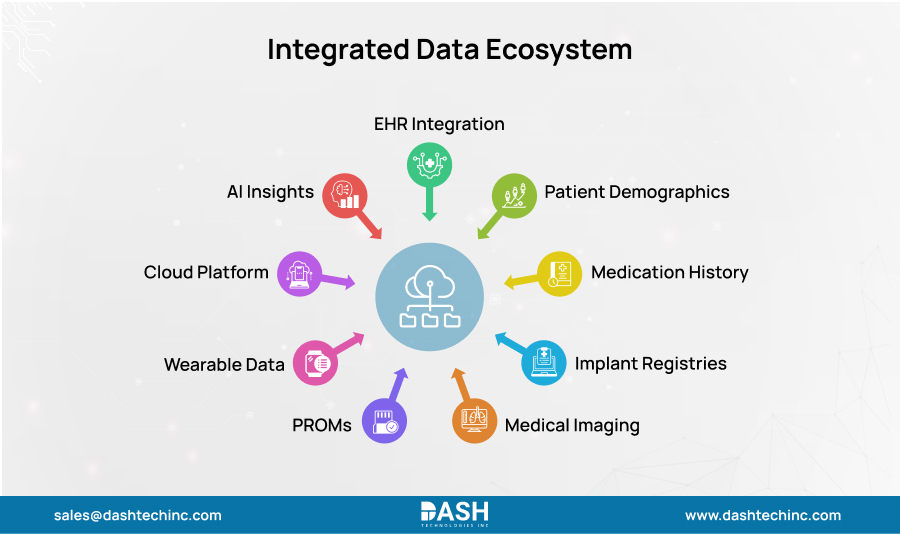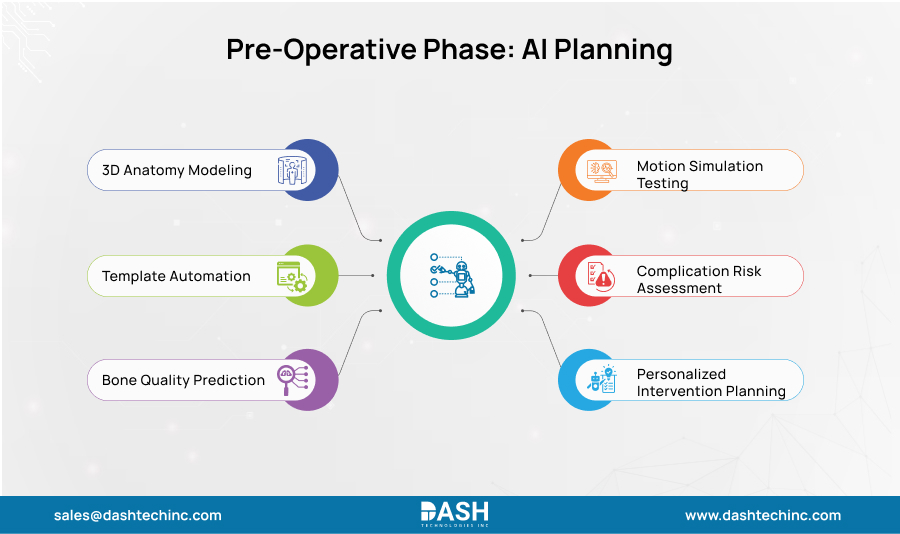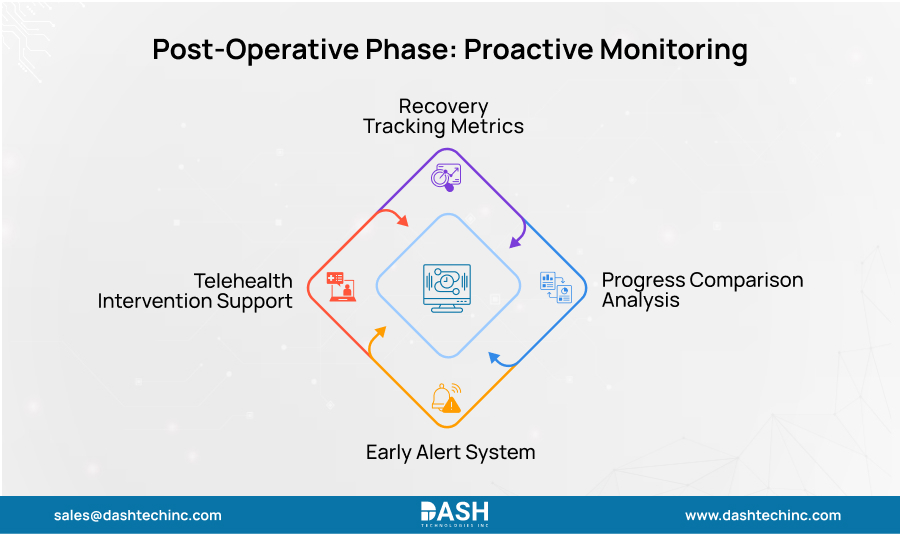AI in Arthroplasty Surgery : Data-Driven Decision Making
Hip arthroplasty or hip replacement surgery has impacted the lives of millions around the globe (in a good way). Data-driven decision making in these procedures helps optimize outcomes and improve patient care. For primary total hip arthroplasty, reported success rates now surpass 95% at 10-year follow-up.
With more than 50,000 revision hip arthroplasties performed each year in the United States alone, and with direct costs now more than $1 billion, the time for data-driven decision making has never been more critical.
AI, EHR integration, predictive analytics, & other MedTech solutions for orthopedics are changing the way orthopedic surgeons treat patients in need of hip replacement surgery by providing the tools to help reduce revision rates and improve outcomes.
Understanding Hip Arthroplasty and Revision Challenges
Hip arthroplasty is the procedure for replacing the damaged hip joint with prosthetic components, usually consisting of a femoral stem, acetabular cup, and bearing surfaces. While the procedure is highly successful, there are certain reasons why revision is required:
- Aseptic loosening (mechanical failure)
- Periprosthetic infections
- Instability and dislocation
- Wear of bearing surfaces
- Periprosthetic fractures
- Adverse reactions to metal debris
The traditional model attempts to surmount these challenges with a single approach that fits all. Surgeons depend upon two-dimensional X-rays, their immediate intuitions in the operating room, and their valuable, though necessarily subjective, experience. Although they may sense that a particular type of patient is at higher risk for dislocation, quantifying that risk & customizing the surgical plan with precision has been a challenging objective to meet.
AI-powered surgical decision support is creating new digital health solutions in which orthopedic surgeons can choose & plan while also optimizing their implant selection, surgery, & post-operative care.
Are You Attending Ortho Summit 2025?
Join us to explore the latest in orthopedic innovation, AI-driven solutions, and smarter surgical care with industry leaders.
Let’s Connect at Ortho Summit!AI in Arthroplasty Surgery: Transforming Clinical Practice
AI in arthroplasty surgery involves different technologies used in planning, conducting, & follow-up care. AI-powered surgical decision support analyzes enormous quantities of data to recognize patterns that are not visible to the human naked eye, eventually forecasting outcomes with high precision.
Machine Learning Applications
- Predictive Analytics: Artificial intelligence algorithms are used to identify the highest risk patients for revision surgery based on their medical history. Machine learning models that include hundreds of variables at once can provide risk stratification algorithms to guide implant selection and surgical technique more effectively.
- Pattern Recognition: Machine learning systems detect nuanced patterns in AI-enabled medical imaging data, patient traits, and surgical factors that are associated with favorable long-term results. This ability allows surgeons to better decide on implant choice & surgical methods.
- Real-Time Decision Support: AI systems assist surgeons in achieving optimal alignment & stability during surgery by giving them real-time feedback on component positioning. These instruments enhance consistency of results and lessen variation in surgical technique.
Building the Foundation: The Integrated Data Ecosystem

The strength of data-driven decision making is in direct proportion to the quality & completeness of data it is subjected to. Maintaining fragmented and siloed patient information systems is now an obsolete practice.
EHR Integration: The Single Source of Truth
Electronic Health Records (EHRs) are the digital cornerstone of patient care. The first and most critical step is effective EHR integration. This goes beyond simple digitization of records; it’s about creating an interoperable data platform where info flows seamlessly. A full EHR integration is the foundation, providing the longitudinal data critical for predictive modeling: patient demographics, comorbidities (diabetes, obesity that may increase risk), medication history, prior surgical outcomes, etc. Without this central core, any AI in Arthroplasty surgery initiative is flying blind.
Beyond the EHR: Enriching the Data Pool
EHRs are a great start, but they are far from the whole story. Other data resources can help create a more comprehensive and powerful orthopedic data ecosystem. These include:
- Implant Registries: National or institutional databases that track the long-term performance of specific implants in thousands of patients.
- Medical Imaging Archives (PACS): Centralized repositories of X-rays, CT scans, MRIs, etc, are another invaluable resource to train AI models for AI in Arthroplasty surgery.
- Patient-Reported Outcome Measures (PROMs): Digital PROMs are patient surveys that capture the patient’s pain and functional status as well as his/her overall quality of life following a surgical procedure.
- Wearable and Sensor Data: Wearable and sensor data include post-operative data gathered via wearable sensors and smartwatches, which closely track a patient’s gait symmetry, mobility, & activity. These digital health devices offer precious objective information regarding the recovery process.
By bringing together these disparate sources, often on a secure cloud platform, we have a more complete, multi-dimensional view of each patient. This information is the fuel that powers the AI engine for better decision-making at every stage of MedTech solutions for orthopedics.
Pre-Operative Phase: Personalizing the Plan with AI

The greatest opportunity to prevent revision lies in meticulous pre-operative planning. This is where AI-powered surgical decision support shines, turning guesswork into data-backed science.
Traditionally, surgeons use 2D X-ray films & transparent templates to estimate the right implant size and position. While this has been an effective system, it is also somewhat inaccurate. AI-enabled medical imaging is different. An AI algorithm that reviews a patient’s pre-operative CT scan data can generate an exact 3D representation of the patient’s individual hip anatomy.
From this model, the system can:
- Automate Templating: Recommend the optimal implant type, size, and orientation (anteversion and inclination angles) to replicate the patient’s natural anatomy and maximize stability.
- Predict Bone Quality: Analyse the bone density from the CT scan to highlight areas of poor bone stock that may need specific attention, or a different type of implant.
- Simulate Range of Motion: Perform virtual simulations of how the chosen implant will perform as the patient walks, sits, and bends to predict and prevent impingement (bone or implant rubbing on one another), a common cause of pain and wear.
Moreover, predictive analytics models can evaluate the full spectrum of a patient’s data in the EHR to determine their individualized risk score for a complication such as infection, dislocation, or venous thromboembolism. A high-risk patient for dislocation may be treated with a dual-mobility implant, or a patient at high risk for infection may be subject to a rigorous pre-operative optimization protocol. This is real personalization at work.
Post-Operative Phase: Closing the Loop with Proactive Monitoring

Patient care doesn’t end when they leave the hospital. The post-operative period is another long, critical tail for a successful patient outcome that is ripe for a data-driven decision-making process.
Digital health solutions such as smartphone apps and wearable sensors can shift provider care from reactive to proactive. We no longer need to react to a patient’s complaint at their six-week follow-up appointment. We can monitor their recovery almost in real time.
Objective Recovery Tracking: A wearable sensor on the ankle can track step count, walking speed, and gait symmetry. An AI algorithm can compare this data to an expected recovery curve for that patient’s specific profile.
Early Warning Systems: A sudden decline in activity, a change in gait, or spikes in pain reported by the patient on a PROM survey could trigger an alert. This enables clinical teams to intervene early, using a telehealth check, before a minor issue (a developing wound concern, or muscle weakness) becomes a major problem (a full-blown infection or dislocation).
Finally, and perhaps most importantly, all this post-op data isn’t simply for the benefit of the patient alone. It is fed back into the central data ecosystem. By correlating post-operative outcomes with pre-operative plans and intra-operative data, the AI models learn and improve. Did patients with a certain implant orientation have faster recoveries? Did that pre-habilitation plan produce better early mobility outcomes? This is the continuous feedback loop that’s the engine of data-driven decision making. Every surgery you do makes the next one smarter.
Looking to implement some of these solutions into your own orthopedic practice or MedTech product? We build custom AI-driven solutions, EHR integrations, and digital health platforms to improve patient outcomes. Reach out to DASH to learn how our custom-fit solutions can reduce revision rates and improve patient care in your organization.
About Dash

Dash Technologies Inc.
We’re technology experts with a passion for bringing concepts to life. By leveraging a unique, consultative process and an agile development approach, we translate business challenges into technology solutions Get in touch.






